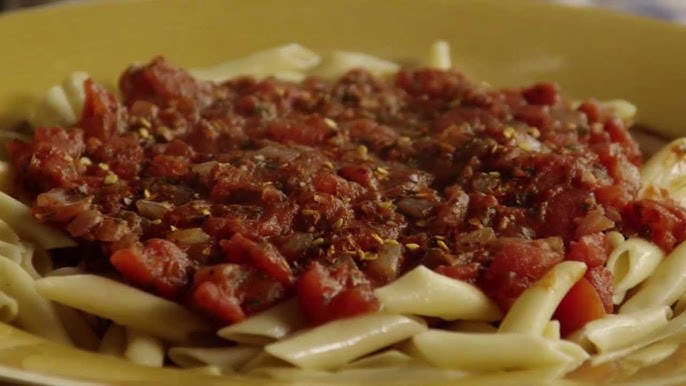Arrabbiata Sauce Recipe: Arrabbiata sauce is one of those fiery, bold Italian sauces that just screams flavor. Originating from Rome, its name literally means “angry” in Italian, and that heat? Oh, it lives up to the name. Made with a few simple ingredients like tomatoes, garlic, olive oil, and chili flakes, this spicy tomato sauce can elevate your pasta night in ways you didn’t think were possible.
Whether you’re looking to impress guests, spice up a weeknight dinner, or simply indulge in a delicious, comforting meal, this step-by-step guide will help you master the art of making traditional Arrabbiata sauce from scratch.
This isn’t just a recipe—it’s a love letter to simplicity, heat, and Italian cuisine.
List of Ingredients You’ll Need
Making a great Arrabbiata sauce starts with having the right ingredients on hand. The beauty of this sauce lies in its simplicity, so using fresh, high-quality components will really make your dish shine.
Essential Ingredients
- Olive oil – Extra virgin olive oil is the base of flavor here. Rich, fruity, and smooth, it gives the sauce a luxurious mouthfeel.
- Garlic (4–6 cloves) – Minced finely. Fresh garlic is non-negotiable for the best flavor.
- Red chili flakes (1 to 2 tsp) – Adjust based on your heat tolerance.
- Whole peeled tomatoes (1 can – 28 oz) or 6–8 fresh tomatoes – If using canned, San Marzano is highly recommended.
- Salt (to taste) – Always add gradually and taste as you go.
Optional Additions for More Depth
- Onion (1 small, finely chopped) – Not traditional, but adds sweetness and depth.
- Fresh herbs (basil, parsley) – Add at the end for freshness.
- Black pepper (a pinch) – Enhances overall flavor.
- Parmesan cheese (for serving) – Optional but delicious.
Substitution Ideas
- Tomatoes: If you’re out of canned tomatoes, try crushed tomatoes or tomato puree.
- Chili flakes: Can sub with fresh chopped chilies or chili paste.
- Garlic: In emergencies, use garlic powder—but only if you must.
The goal is to balance the tanginess of the tomatoes with the richness of olive oil and the kick from the chili flakes. When those elements come together, it’s magic.
Tools & Equipment You’ll Need
You don’t need a fancy kitchen setup to pull off a great Arrabbiata sauce. In fact, it’s probably one of the easiest dishes in terms of equipment.
Basic Tools
- Large saucepan or skillet
- Wooden spoon or heatproof spatula
- Sharp knife and cutting board
- Can opener (if using canned tomatoes)
- Blender or immersion blender (optional for smooth texture)
Nice-to-Have Tools
- Garlic press – Speeds up mincing
- Fine mesh strainer – If you want a smooth, refined sauce
- Pasta pot – Because what’s Arrabbiata without pasta?
As long as you have a good pan and some heat, you’re halfway there.
Choosing the Right Tomatoes
Tomatoes are the heart of Arrabbiata sauce, so let’s get this part right. They bring the acidity, sweetness, and body to the dish.
Fresh vs. Canned
- Fresh tomatoes: Roma or plum tomatoes are best. Boil, peel, and chop them before use.
- Canned tomatoes: Go for whole peeled San Marzano tomatoes. They’re sweeter, less acidic, and incredibly flavorful.
Preparing Fresh Tomatoes
- Score the bottoms with an “X”
- Blanch in boiling water for 30 seconds
- Transfer to ice bath
- Peel and chop
It’s more work, but the flavor payoff is worth it if you’re using seasonal tomatoes.
The Role of Olive Oil in Arrabbiata Sauce
Let’s take a moment to talk about olive oil—because this isn’t just the grease you toss into the pan. Olive oil is foundational in Arrabbiata sauce. It’s not just there to cook the garlic; it delivers depth, richness, and that unmistakably smooth texture that makes this sauce so irresistible.
Why Olive Oil Matters
A good extra virgin olive oil acts almost like a flavor bridge. It mellows the acidity of the tomatoes, brings out the sweetness of garlic, and carries the heat of the chili flakes all through the sauce. Without it, the sauce can taste thin and flat. Think of it as the secret agent working behind the scenes to pull everything together.
What Type Should You Use?
- Extra virgin olive oil is your best bet. Look for a cold-pressed variety with a greenish hue and a slightly peppery aftertaste.
- Avoid light or refined oils—they lack the flavor punch we’re going for.
How Much to Use?
For one batch of Arrabbiata sauce (serving about 4 people), 3 to 4 tablespoons of olive oil is ideal. It may seem like a lot, but remember, this isn’t just to prevent sticking—this is a flavor layer.
Let’s Talk About Garlic
Garlic is the soul of Arrabbiata sauce. When sautéed just right, it gives off that rich, aromatic scent that lets everyone in the house know something delicious is coming. It’s that friend who shows up early to the party and gets everything started.
Fresh vs Powdered Garlic
- Fresh garlic is the only way to go for authenticity and flavor.
- Powdered garlic? Forget it—unless you’re absolutely desperate.
How to Prep It
- Use 4–6 cloves, depending on your garlic love level.
- Mince it fine, or use a garlic press for an even finer texture.
- You can slice it thin if you prefer little slivers in the sauce.
Pro Tips for Cooking Garlic
- Low and slow: Don’t crank up the heat. Garlic burns fast and bitter garlic can ruin your sauce.
- Golden, not brown: When it turns a soft golden color and the smell hits your nose—that’s when it’s ready for the chili flakes.
Garlic and olive oil working together? That’s culinary harmony.
Getting the Heat Right with Red Chili Flakes
Now, let’s bring the “angry” into Arrabbiata. The spice. The fire. The flavor kick that makes your tongue tingle. That’s what the red chili flakes are here for.
How Much Heat is Enough?
This is where personal preference kicks in. For a classic medium heat:
- Start with 1 teaspoon of red pepper flakes.
- Like it hotter? Go for 1.5 to 2 teaspoons.
- Not sure? Add less during cooking and more at the end.
Remember, you can always add more spice—but you can’t take it out once it’s in.
Best Practices
- Bloom your chili flakes in hot oil after sautéing garlic. This releases their oils and boosts the heat.
- Test before adding salt—sometimes chili flakes also bring a little saltiness.
Substitute Ideas
- Fresh red chili peppers: Finely chopped and added with garlic.
- Chili paste: Like Calabrian chili paste for deeper flavor.
Spicy doesn’t mean unbearable—it means exciting.
Optional Additions: To Onion or Not to Onion?
Here’s where opinions vary. Traditional Arrabbiata sauce is onion-free. It’s supposed to be punchy, sharp, and straightforward. But many modern versions add a finely chopped onion for a touch of sweetness and complexity.
The Case for Onions
- Adds sweetness to balance the acidity of the tomatoes.
- Gives a more rounded flavor, especially if the tomatoes are super tart.
How to Use It
- Use 1 small yellow or white onion, finely chopped.
- Sauté it with garlic until soft and translucent—don’t brown it.
Should You Add It?
- Purist? Skip it.
- Looking for depth? Add it.
There’s no wrong choice here—just different delicious outcomes.
Step-by-Step Guide to Making Arrabbiata Sauce
Alright, let’s get into the meat of it—well, the tomatoes of it. This is where all the magic happens. Follow these steps carefully, and you’ll end up with a rich, spicy, flavorful sauce that’s perfect every single time.
Step 1. Heat Your Olive Oil
In a large pan, heat 3–4 tablespoons of extra virgin olive oil over medium heat. Wait until it’s shimmering, but not smoking. This is your flavor base—don’t rush it.
Step 2. Sauté the Garlic (and Onion if Using)
Add your minced garlic (and chopped onion if using) to the pan. Stir frequently.
- Let the garlic become golden (not brown).
- If using onions, cook until they’re soft and translucent—about 5–7 minutes.
Step 3. Add Chili Flakes and Bloom the Spices
Sprinkle in your chili flakes and give them a quick stir—about 30 seconds. This “blooms” the spice, making it fragrant and alive.
Warning: This is the moment your kitchen starts smelling like an Italian grandma’s house (in the best way).
Step 4. Add Tomatoes
Pour in your canned tomatoes (or fresh peeled and chopped tomatoes). If using whole tomatoes, crush them with a spoon or potato masher right in the pan.
- Stir well to combine.
- If you want a smoother sauce later, you can use a blender or immersion blender.
Step 5. Simmer Until Thickened
Lower the heat and let the sauce simmer uncovered for 20–30 minutes, stirring occasionally. You want it thick and glossy, not watery.
Step 6. Season and Taste Test
Add salt to taste. If your tomatoes are very acidic, add a pinch of sugar to balance it out.
Optional: Add a bit of black pepper for an extra kick.
Step 7. Add Fresh Herbs (Optional)
If you’re using basil or parsley, stir them in at the very end, just before serving. This keeps their flavor bright and fresh.
Step 8. Blend or Keep It Chunky
Want a rustic sauce? Leave it chunky. Prefer it smooth? Use a hand blender or pour it into a standard blender (carefully!).
Step 9. Finish with Parmesan or Leave Vegan
Once it’s done, feel free to sprinkle in a little freshly grated Parmesan cheese for richness. Or leave it off if you’re keeping it vegan.
Step 10. Serving Suggestions
Toss the sauce with your favorite al dente pasta, drizzle with olive oil, top with Parmesan or chili flakes, and serve immediately.
- Pairs great with penne, spaghetti, or even gnocchi.
- Serve with a slice of crusty bread to mop up every drop.
Tips for the Perfect Arrabbiata Every Time
Mastering Arrabbiata sauce isn’t just about following the steps—it’s about learning the rhythm of the sauce. Every ingredient plays a role, every minute counts. These insider tips will help you avoid rookie mistakes and make sure your sauce turns out incredible every single time.
1. Don’t Burn the Garlic
This is the number one mistake. Garlic cooks fast, and once it goes from golden to brown, the flavor changes from rich and mellow to bitter and burnt. As soon as it turns a light gold and smells fragrant, it’s time to move to the next step.
2. Control the Heat
High heat can ruin your sauce. From blooming spices too aggressively to overcooking tomatoes, rushing the process leads to sharp, unbalanced flavors. Keep it low and slow once your tomatoes are in. Let the sauce simmer and reduce naturally for 20–30 minutes.
3. Taste as You Go
This isn’t baking—it’s cooking. That means you should be tasting your sauce at every stage. Add salt slowly, adjust chili to your liking, and throw in a pinch of sugar if your tomatoes are too acidic.
4. Use Quality Ingredients
With so few ingredients, each one matters. Use high-quality olive oil, fresh garlic, and good tomatoes (San Marzano canned or ripe fresh tomatoes). They make all the difference.
5. Rest the Sauce Before Serving
Let the sauce sit off the heat for 5–10 minutes before you toss it with pasta. This allows the flavors to settle and blend fully, giving you a richer taste overall.
Bonus Tip: Save Pasta Water
If you’re tossing the sauce with pasta, add a few tablespoons of pasta cooking water to the sauce. It helps the sauce cling to the noodles beautifully and adds a little creaminess thanks to the starch.
These little tweaks are what separate a good Arrabbiata from a great one.
How to Store and Reheat Arrabbiata Sauce
Leftover sauce? Lucky you. Arrabbiata keeps well and arguably tastes even better the next day as the flavors deepen.
Storing in the Fridge
- Let the sauce cool completely before storing.
- Transfer it to an airtight container.
- It will keep well in the fridge for up to 5 days.
Freezing Arrabbiata Sauce
- Perfect for meal prep.
- Pour cooled sauce into a freezer-safe container or zip-top freezer bag (lay it flat to save space).
- Freeze for up to 3 months.
- Label with date and spice level if you make different batches.
Reheating Tips
- Reheat in a saucepan over low to medium heat.
- Stir occasionally and add a splash of water if it’s too thick.
- You can also microwave in short bursts, stirring in between.
Make sure to reheat thoroughly until steaming hot, especially if adding it to a new pasta dish.
Pairing Ideas: What to Serve with Arrabbiata Sauce
Arrabbiata is most often paired with pasta, but its spicy, bold flavor works with so much more than just noodles. Here’s how to make a full meal around it.
Perfect Pasta Pairings
- Penne – The classic. Its tube shape holds the sauce perfectly.
- Spaghetti – Twirls beautifully and soaks in all that spicy goodness.
- Farfalle or Fusilli – Great for holding chunky sauces.
Cook your pasta al dente, and always toss it with the sauce rather than just pouring it on top.
Protein Options
- Grilled chicken – A lean, simple way to make it a full meal.
- Shrimp – Spicy tomato sauce + juicy shrimp = match made in heaven.
- Tofu or tempeh – For a vegetarian or vegan-friendly protein.
Sides That Shine
- Garlic bread – Because more garlic is never a bad thing.
- Side salad – Arugula with lemon dressing cuts through the spice.
- Grilled vegetables – Eggplant, zucchini, or bell peppers work great.
Wine Pairing
Go for a medium-bodied red wine like Chianti or Barbera. The acidity in the wine balances beautifully with the tomatoes, and the subtle sweetness plays off the chili heat.
Making it Vegan or Gluten-Free
One of the best things about Arrabbiata sauce is that it’s naturally vegan and gluten-free—as long as you watch your additions and pairings.
For a Vegan Version
- The base sauce is already vegan.
- Just skip Parmesan cheese or use a plant-based alternative.
- Add roasted veggies or plant-based protein like lentils, mushrooms, or tofu.
For a Gluten-Free Version
- Use gluten-free pasta made from rice, corn, chickpeas, or quinoa.
- Double-check that your chili flakes and canned tomatoes are certified GF (most are, but it’s always good to be sure).
By keeping these tips in mind, you can make a dish that’s just as delicious while meeting your dietary needs.
Common Mistakes to Avoid
Even though this is a simple recipe, there are still a few ways it can go sideways. Don’t worry—we’ve got your back.
1. Overcooking the Garlic
Garlic should be golden, not dark brown or burnt. Burnt garlic turns the entire sauce bitter.
2. Using Watery Tomatoes
If you use low-quality or out-of-season fresh tomatoes, your sauce can end up bland or watery. Either cook it longer to reduce or switch to canned high-quality tomatoes like San Marzano.
3. Skipping the Blooming Step
Don’t just throw chili flakes in with the tomatoes. Blooming them in hot oil before adding tomatoes is what releases the flavor.
4. Not Seasoning Enough
Tomatoes need salt to come alive. Always taste and adjust salt levels at least twice—once after adding the tomatoes, and again before serving.
5. Letting the Sauce Sit Too Long Uncovered
If you forget about your sauce and let it simmer too long without stirring, it can burn on the bottom. Stir every few minutes and keep an eye on it.
Avoiding these mistakes ensures a smooth, rich, flavorful sauce every single time.
Nutritional Information (Per Serving)
If you’re keeping an eye on your nutrition, here’s the good news: Arrabbiata sauce is not only flavorful, but it’s also light and healthy. It’s low in calories, fat, and sugar—while being packed with nutrients from tomatoes and garlic. Here’s a breakdown of a typical serving (about 1/2 cup of sauce):
| Nutrient | Amount per Serving |
|---|---|
| Calories | 110 |
| Total Fat | 7g |
| Saturated Fat | 1g |
| Carbohydrates | 10g |
| Sugar | 6g |
| Fiber | 2g |
| Protein | 2g |
| Sodium | 300mg (varies) |
| Vitamin C | 15% of daily value |
| Lycopene (from tomatoes) | High |
What Makes It So Nutritious?
- Tomatoes are rich in lycopene, an antioxidant that supports heart health.
- Garlic has natural anti-inflammatory and immune-boosting properties.
- Olive oil provides healthy fats and helps absorb the nutrients in tomatoes more efficiently.
This sauce proves you don’t need heavy cream or loads of cheese to enjoy something satisfying and full of depth.
If you’re tracking macros or managing dietary goals, Arrabbiata is an excellent choice to include in your weekly meal rotation.
FAQs about Arrabbiata Sauce Recipe
1. Can I make Arrabbiata Sauce without chili flakes?
Yes, but it won’t be Arrabbiata without the “angry” heat. You can substitute with fresh red chilies, chili paste, or even a dash of hot sauce—but something spicy is key to keeping the spirit of the sauce alive.
2. What pasta works best with Arrabbiata?
Penne is the traditional go-to, thanks to its tube shape that holds the sauce perfectly. But you can also use spaghetti, rigatoni, fusilli, or even ravioli for a twist.
3. Can I make this ahead of time?
Absolutely. Arrabbiata sauce actually tastes even better the next day. Store it in the fridge for up to 5 days, or freeze it for up to 3 months. Just reheat gently on the stove or in the microwave.
4. How spicy is traditional Arrabbiata?
It’s typically medium to hot—but it’s totally adjustable. If you’re not a fan of too much heat, start with half a teaspoon of chili flakes and add more to taste. Want it fiery? Crank it up!
5. Can I freeze Arrabbiata Sauce?
Yes! It freezes beautifully. Just make sure to let it cool completely before transferring to airtight containers or freezer bags. It keeps for up to 3 months and tastes just as great when reheated.
Conclusion
There you have it—the full guide to making authentic, flavorful, and spicy Arrabbiata sauce right in your own kitchen. From choosing the best tomatoes to getting the garlic just right, every step we covered helps build a sauce that’s bold, fresh, and totally unforgettable.
Whether you’re making a quick weeknight pasta or prepping a romantic Italian dinner, Arrabbiata brings the heat and heart of Rome into your home. It’s a simple dish, yes—but one that rewards attention to detail and love for real flavor.
So next time you’re tempted to grab a jar of store-bought sauce—don’t. You’ve got everything you need to make it better, spicier, and more delicious from scratch. Trust yourself. Light the stove. Let that garlic sizzle. And dive headfirst into the world of homemade Arrabbiata.



